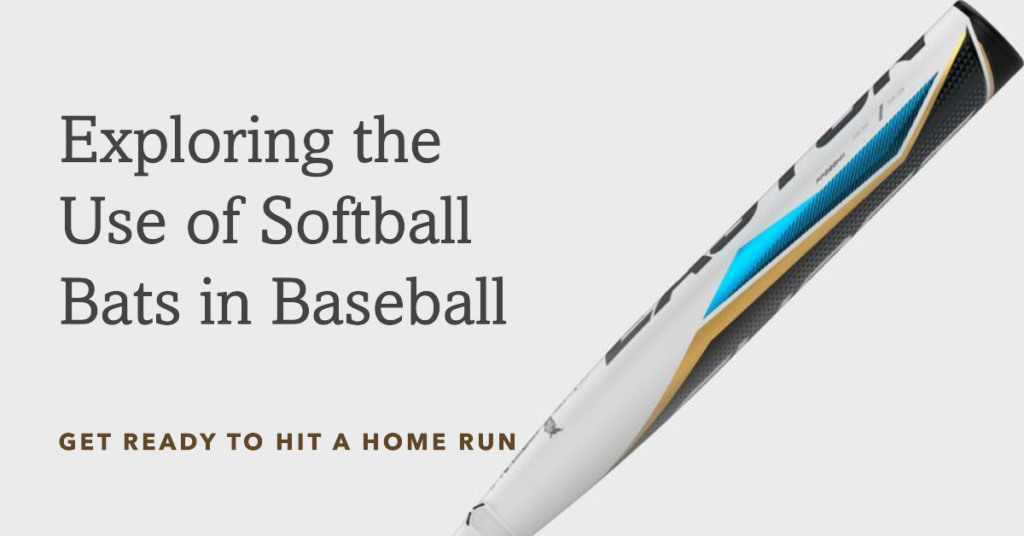Yes, a softball bat can be used for baseball. Softball and baseball are similar but have a few key differences.
While both sports involve hitting a ball with a bat, the balls used in softball and baseball differ in size and hardness. Softball bats are designed to hit giant, softer balls, while baseball bats are designed for more petite, more rigid balls.
Because of these differences, using a softball bat for baseball may not provide optimal performance. A softball bat’s larger barrel and lighter weight can make it more difficult to control the more minor, faster-moving baseball. Additionally, the construction and materials of a softball bat may not be ideal for the demands of baseball, which can result in decreased power and durability. While it is technically possible to use a softball bat for baseball, it is generally recommended to use a bat designed explicitly for baseball to ensure the best performance and safety.
Understanding The Differences Between Softball And Baseball Bats
Softball and baseball bats are designed differently to suit the unique needs of each sport. While it is technically possible to use a softball bat for baseball, it may not provide the same level of performance due to variations in size, weight, and composition.
Understanding these differences is crucial for players looking to optimize their performance on the field.
Softball Bats Vs. Baseball Bats: Key Distinctions
Softball and baseball may seem similar, but there are notable differences between the two sports. The equipment used, particularly the bats, can significantly vary. Let’s delve into the critical distinctions between softball bats and baseball bats.
- Weight and length: Softball bats are shorter and heavier than baseball bats. While softball bats are typically 34 inches long, baseball bats are usually around 32 inches long. The weight difference is significant, with softball bats weighing about 26 to 30 ounces while baseball bats range from 28 to 34 ounces.
- Barrel diameter: The barrel diameter of a bat affects its speed and power. Softball bats have larger barrel diameters, typically 2.25 to 2.75 inches. In contrast, baseball bats have smaller barrel diameters, usually around 2.625 to 2.75 inches.
- Bat taper refers to transitioning from the barrel to the bat’s handle. Softball bats tend to taper gradually, resulting in a smooth, continuous shape. On the other hand, baseball bats often have a more pronounced taper, allowing for a better grip and swing control.
- Bat composition: Softball bats and baseball bats are constructed differently due to the varying needs of the sports. Softball bats are predominantly made of composite materials or aluminum alloys, offering greater flexibility and enhancing bat speed. On the other hand, baseball bats are usually constructed with wood, aluminum, or a combination of the two.
Factors To Consider When Choosing A Bat For Baseball
Choosing the right bat for baseball is crucial, as it can significantly impact performance. Here are some factors to consider before purchasing a baseball bat:
- League regulations: Different baseball leagues have specific rules and regulations regarding bat requirements. Ensure the bat you choose complies with the league’s guidelines to avoid unnecessary penalties.
- Player age and size: The player’s age and size should be considered when selecting a bat. Younger players may benefit from lighter and shorter bats, while older players can handle heavier and longer bats for more power.
- Bat material: Baseball bats are available in various materials, including wood, aluminum, and composite. Each material offers different benefits and drawbacks. Wood bats provide a traditional feel but may be less durable. Aluminum bats are known for their durability and increased power, while composite bats offer enhanced performance and reduced sting vibrations.
- Swing preference: Understanding your swing style is vital in determining the ideal baseball bat. Some players prefer balanced bats, evenly distributing weight throughout the bat, while others opt for end-loaded bats, which concentrate more weight at the end for added power.
Power And Performance Variations Between Softball And Baseball Bats
The power and performance of softball and baseball bats differ due to their unique characteristics. Here are the main variations:
- Power potential: Softball bats are specifically designed to maximize power and distance due to their larger barrel diameter and weight. Conversely, baseball bats are engineered for better bat speed and control, emphasizing contact and precision rather than sheer power.
- Sweet spot: The sweet spot refers to the area on the bat where a ball’s impact produces maximum velocity and distance. Softball bats have more prominent sweet spots, enhancing the chances of solid hits. Baseball bats generally have more minor charming areas, requiring more precise contact to achieve optimal results.
- Bat speed: Baseball bats are typically lighter and offer quicker swing speeds than softball bats. The faster swing allows baseball players to react swiftly to pitched balls, making contact with greater precision. Softball bats, with their heavier weight, require more power-driven swings.
It is essential when choosing the right equipment for each sport. Consider factors such as weight, length, barrel diameter, and composition to find the perfect bat that suits your needs and improves your performance on the field.
Exploring The Power Difference Between Softball And Baseball Bats
Softball and baseball bats have noticeable power differences due to their distinct designs and regulations. While using a softball bat for baseball is possible, the results may vary in performance and effectiveness on the field. Nonetheless, it’s essential to consider each sport’s specific requirements and limitations to achieve optimal results.
Playing baseball or softball requires skill and skill, technique and maximizing your performance on the field. One crucial piece of equipment that significantly impacts the game is the bat. While both sports share similarities, the differences in bat design and specifications can substantially affect power and performance.
This section will examine the differences between softball and baseball bats, focusing on three key factors: bat weight and length, barrel size and diameter, and bat material.
The Impact Of Bat Weight And Length On Power:
Wielding a length plays a significant role in determining the power behind each swing. Here are some points to consider:
- Bat Weight:
- A heavier bat generally produces more power, enabling players to generate incredible momentum during a swing.
- However, a heavier bat might sacrifice swing speed and control, potentially impacting overall performance.
- Bat Length:
- A longer bat provides greater reach and a wider swing, potentially resulting in increased increases. A longer bat might be more challenging to control, impacting accuracy and timing.
Analysis Of Barrel Size And Diameter About Power:
A bat’s barrel, or hitting surface, also contributes to the power generated when contacting the ball. Consider these aspects:
- Barrel Size:
- A larger barrel surface area allows for a more prominent sweet spot, enhancing the chance of solid contact and increased power.
- However, a larger barrel might weigh more, affecting swing speed and control.
- Barrel Diameter:
- The diameter of the barrel barrels’ diameter effect,” or the flexing of the bat upon contact, can increase the ball’s exit speed.
- Regulations in both baseball and softball limit barrel diameter to maintain fair play and safety.
Understanding The Effects Of Bat Material On Power:
The type of material used to construct a bat can significantly influence performance. Here’s what you should know:
- Wood Bats:
- Wood bats were used in baseball, offering a classic f in baseball and sound.
- Wood bats require precise technique due to their narrower sweet spot, but they can deliver great power when hit correctly.
- Aluminum and Composite Bats:
- Both aluminum and composite bats are popular in baseband for their durability and performance-enhancing characteristics.
- These bats often have more prominent sweet spots compared to wood, resulting in increased power potential when making contact.
Each of these factors contributes to softball and baseball bats. Understanding these nuances can help you make an informed decision on the bat for your game. Whether you are a baseball enthusiast or a softball lover, having the fan in your hands can make all the difference in winning home runs and achieving optimal power on the field.
How Using A Softball Bat Affects Baseball Performance
Using a softball bat for baseball can impact performance, as the bat’s length, weight, and balance differ. It may affect swing speed, power, and accuracy, requiring adjustments from the player to adapt effectively. Understanding these differences is vital to optimizing baseball perf.
Can You Use A Softball Bat For Baseball
If you’re a baseball player looking to experiment with your gear, you might wonder if a softball bat can be used in baseball games. While both sports share similarities, the equipment used is quite different. In this blog post, we’ll explore the impact of using a softball bat for baseball and provide insights into the pros and cons, the influence of bat speed and swing mechanics on power transfer, and the potential consequences of using a softball bat in baseball games.
Pros And Cons Of Using A Softball Bat For Baseball:
- Increased bat speed: Softball bats are often lighter than baseball bats, allowing for potentially higher bat speed. This could translate to increased power and better performance at the plate.
- More prominent sweet spot: Softball bats tend to have more prominent charming areas, which can provide solid contact with the ball. This could lead to more consistent hits and potentially improved batting averages.
- Different weight distribution: Softball bats are typically end-loaded, meaning their weight is distributed towards the end of the barrel. This distribution can affect the swing mechanics and power transfer of a baseball swing, potentially leading to adjustments in hitting technique.
- Durability concerns: Softball bats are not designed to withstand baseball’s high-velocity, high-velocity pitches. Using a softball bat in baseball games may increase the likelihood of the bat breaking or becoming damaged.
- Rule compliance: Baseball leagues and organizations often have specific rules regarding the type of bat that can be used. Using a softball bat in a baseball game may result in penalties or disqualification for violating these rules.
The Influence Of Bat Speed And Swing Mechanics On Power Transfer:
- Bat speed: Bat speed plays a crucial role in power transfer, and the distance a ball will travel when hit. By using a softball bat, which is typically lighter, players may be able to generate higher bat speeds, resulting in increased power potential.
- Swing mechanics: The mechanics of a swing differ between softball and baseball due to factors like pitch speed, timing, and angle of attack. While using a softball bat in baseball may affect the swing mechanics, players can adapt and make necessary adjustments to optimize power transfer.
Potential Consequences Of Using A Softball Bat In Baseball Games:
- Decreased control: Due to the weight distribution and design variations between softball and baseball bats, using a softball bat in baseball games may lead to reduced control over the bat. This can affect the precision and direction of hits.
- Reduced power against high-velocity pitches: Baseball pitchers often throw with more incredible velocity compared to softballthanUsing a softball bat may limit the player’s ability to generate the same energy against high-velocity rises, potentially resulting in weaker hits.
- Risk of bat breakage: The construction and durability of softball bats may not withstand the demands of baseball, especially when facing higher velocity pitches. Using a softball bat in baseball games increases the risk of bat breakage or damage.
While using a softball bat in baseball games can have advantages in increased bat speed and a more prominent sweet spot, it also brings potential downsides such as reduced control and increased risk of bat breakage. Players should carefully consider the rules and regulations of their league or organization before using a softbausing baseball setting.
It may be beneficial to try out a variety of baseball bats specifically designed for the sport to optimize performance and minimize potential drawbacks.
Increased Power Potential With A Softball Bat: Myth Or Reality?
Learn the facts about using a softball bat for baseball and discover if the increased power potential is a myth or a reality. Explore the possibilities and limitations of crossover equipment for a more informed decision.
Analyzing The Potential Power Advantage Of Softball Bats:
Softball bats have long been considered a controversial topic in business, and using a softball bat can increase a batter’s edge on the field. But is this claim just a myth, or is there some truth to it?
Let’s look at the evidence and studies surrounding the use of softball bats in baseball.
Evidence And Studies Supporting Or Debunking The Myth:
- Softball bats are typically designed to hit larger and softer balls, leading some to believe their construction generates more power when used in baseball. However, several studies have shown mixed results, indicating that the impact of using a softball bat for baseball may not be as significant as initially thought.
- Research conducted by experts suggests that while there might be a slight advantage in power potential with a softball bat, it is not substantial enough to justify its usage in baseball. The critical factor lies in the dynamics of the bat aion, which affect the tr dynamicsansfer of energy and ultimately the distal, once covered, by the hit.
- One study observed that the narrower barrel of a baseball bat compared to a softball bat results in a smaller sweet spot, decreasing the chance of generating maximum power. This implies that the structural differences between the two bats may offset any potential advantages of using a softball bat for baseball.
- Another important consideration is the impact of swinging mechanics. Baseball and softball players use different techniques due to factors like pitch improvement. Swinging a softball bat in baseball may lead to a suboptimal swing path, reducing the chances of harnessing the full power potential.
Impact Of Rule Changes And Regulations On Cross-Sport Bat Usage:
- To maintain fairness and preserve the integrity of the game, baseball organizations have implemented rules and regulations regarding bat usage. These guidelines often specify the allowed dimensions and materials for bats used in baseball. As a result, using a softball bat in a baseball game would violate these regulations and result in penalties.
- It’s worth noting that the rules governing the use of bats have become stricter over the years to create a level playing field for all players. These regulations account for technological advancements and aim to prevent any imbalance between ers and pitchers.
- The enforcement of these rules ensures that cross-sport bat usage, such as using a softball bat in baseball, is not a viable option for players seeking an unfair advantage. Compliance with the established regulations promotes fairness and maintains the integrity of the game.
The premise of increased power potential with a softball bat in baseball remains more of a myth than a reality. While slight advantages may exist, the structural and mechanical differences and simple regulations make using a softball bat in baseball impractical and against the rules.
Players looking to excel in their respective sports are better off using the appropriate equipment designed specifically for baseball.
Adjustments For Using A Softball Bat In A Baseball Game
Using a softball bat in a baseball game requires some adjustments due to differences in bat size and weight. Although possible, play experiences challenges in achieving optimal performance and power.
Techniques And Modifications To Optimize Performance With A Softball Bat:
- Hold the bat slightly higher on the handle to adjust for the longer length and softball the smaller barrel size of the softball bat.
- g bat speed rather than relying on power, as softball bats are usually heavier.
- Remember that a soRememberas is a more prominent sweet spot, so you may need to make minor adjustments to your swing mechanics.
- Practice hitting the ball slightly closer to the handle of the bat handle and power transfer.
- Experiment with grip pressure to find the right balance between control and power.
Challenges Faced When Using A Softball Bat In Baseball:
- Accuracy may be compromised due to a softball bat’s increased length and decreased barrel diameter, making it more challenging to connect with the ball.
- The weight distribution of a softball bat differs from that of a baseball bat, requiring adjustments to swing mechanics and timing.
- The reduced barrel size may decrease power and distance when hitting the ball.
- It may take time to adapt to the different feel of a softball bat, consistency, and timing.
Training Considerations For Athletes Transitioning Between Softball And Baseball Bats:
- Practice using both sUsel bats during training sessions to develop versatility and adaptability.
- Focus on improving hand-eye coordination and adjusting timing to account for the differences in bat length and barrel size.
- Develop consistent and repeatable swing mechanics that can be easily adaptable to both types of bats.
- Work on strength and conditioning exercises specifically targeted in baseball and softball swings.
- Seek guidance from coaches or experienced players who can provide tips and feedback on transitioning between the two types of bats.
Remember, successfully utilizing a softball bat in a baseball game requires technique modifications, adjusting tenges, and implementing specific training considerations. By practicing and adapting, athletes can optimize their performance and make a confident switch between the two types of bats.
Making An Informed Choice: Deciding Between A Softball Or Baseball Bat
Choosing between a softball or baseball bat requires careful consideration based on the specific sport you will be playing. While you technically can use a softball bat for baseball, it may not provide the same level of performance and durability as a baseball bat designed for the game.
Players of both softbaBoth understand the importance of selecting the right bat. While softball and baseball bats seem similar, they have key differences that can impact a player’s performance on the field. Making an informed choice will ensure you have the best bat for your needs and goals.
Here are some factors to consider when choosing the right bat for baseball or softball:
Factors To Consider When Choosing The Right Bat For Baseball Or Softball:
- League Regulations: Before making a decision, it’s crucial to understand the regulations and guidelines set by your league. Certain leagues require specific bats for both baseball and softball, so make sure to check the rules before making a purchase.
- Bat Length and Weight: The length and weight of the bat are important factors to essential baseball bats, which are typically longer and heavier than softball bats, reflecting the ball size and speed difference. Softball bats are shorter and lighter to optimize swing speed.
- Bat Material: Both baseball and softball bats are made from various materials, including aluminum, composite, and wood. Each material has its advantages and disadvantages. Aluminum and composite bats deliver more, while wood bats offer a traditional feel.
- Sweet Spot: The sweet spot refers to the area on the bat where the ball meets with the most power and accuracy. Baseball and softball bats have different charming places due to their sizes and weights. It’s essential to find a finding that aligns with your hitting style.
Identifying The Best is essential Fit For Individual Player Preferences And Goals:
Choosing the right bat goes beyond the technical specifications. Each player has unique preferences and goals that should be considered a softball or baseball bat. Here are some aspects to keep in mind:
- Comfort and Grip: A comfortable grip and overall feel of the bat are crucial for any player. Some players may prefer the thinner handle of a baseball bat, while others might find the wider handle of a softball bat more comfortable.
- Hitting Style and Power: When selecting a bat, understanding is essential when choosing a baby relies on power hits, while softball players often focus on placement and contact hitting. Consider your strengths and style align best with your best align sales.
- Experience Level: Beginners may find starting with a lighter bat easier, while more experienced players may benefit from heavier bats. It’s essential to tailor your bat choice to your experience level to optimize your performance on the field.
Advice For Players Considering Using A Softball Bat In Baseball:
While it may be tempting to use a softball bat in baseball, it’s generally not recommended due to the critical differences between the sports. Here are some important considerations:
- Bat Speed and Control: Softball bats are designed for slower pitching and shorter distances. Using a softball bat in baseball may affect your bat speed, control, and timing due to the lighter weight and shorter length.
- Durability: Baseballs are more complex and denser compared to softballs. Using a softball bat with a thinner barrel in baseball could increase things or break during play.
- Performance Impact: Softball bats are optimized for hitting larger, slower-moving softballs. Using a softball bat in baseball may result in less power and reduced pounding distance, which can impact your overall performance on the field.
To maximize your potential in baseball, it’s recommended to use a baseball bat that aligns with the sport’s specific requirements. Using the appropriate equipment will allow you to utilize your skills and enhance your overall performance fully.
Frequently Asked Questions For Can You Use A Softball Bat For Baseball
Can A Softball Bat Be Used In Baseball?
No, a softball bat cannot be used in baseball. The two sports have different rules and equipment requirements.
Is There A Difference Between A Softball Bat And A Baseball Bat?
Softball and baseball bats differ due to their size, weight, and barrel diameter.
Can You Hit Baseballs With A Composite Bat?
Yes, you can use a composite bat to hit baseballs. Composite bats are commonly used in baseball games.
Is It Harder To Hit A Softball Or A Baseball?
Hitting a softball might be more complex than hitting a baseball due to its larger size and slower speed.
Conclusion
Using a softball bat for baseball may seem convenient, but it’s essential to consider the differences between the two bats. Softball bats are designed to hit giant, slower-moving balls, while baseball bats are optimized for smaller, faster pitches.
Using a softball bat for baseball may result in less effective hitting due to weight, arm size, and bat speed differences. Additionally, using different softball bats in a baseball game could lead to safety concerns as the ball may travel at a higher velocity and pose a greater risk.
While it may be tempting to use a softball bat for baseball, it is generally recommended to use the appropriate bat for each sport to ensure optimal performance and safety. So, if you’re serious about playing baseball, it’s best to invest in a proper baseball bat rather than relying on a softball bat.






